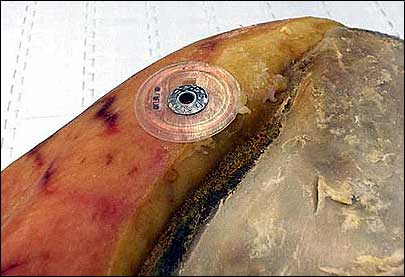Feb 12, 2008Consorzio del Prosciutto di San Daniele, a consortium of ham producers based in the northeastern Italian city of San Daniele del Friuli, has completed the first phases of an RFID-based pilot designed to track the production of prosciutto and verify its authenticity. The group plans to expand tests of the passive RFID system over the next 12 months, eventually requiring its members to adopt the technology.
Founded in 1961, Consorzio del Prosciutto consists of 29 companies that produce the air-cured ham, as well as more than 5,000 pig breeders and 131 slaughterhouses. Altogether, the members produce 37 million kilos (36,400 tons) of the prosciutto per year.

Although San Daniele ham is a trademark protected in 51 countries and registered with the European Union's Protected Designation of Origin (PDO) system, counterfeit versions do turn up, though no statistics are currently available. The main reason the consortium hired consultants to design and test the RFID system was to create a method for verifying a ham's authenticity. The group, however, also sought a way to increase its ongoing efforts to ensure that producers comply with health and hygiene standards. Toward this goal, the consortium eventually hopes to use RFID to track the entire production process, from the time pigs arrive at the slaughterhouse until the prosciutto is sent to warehouses and retail stores.
"We want to protect the consumer so that each person knows the story of each ham through RFID, including when the pig was born and details about its life and death," says Paola Visentin, a spokeswoman for Softwork, the company that designed and tested the system. Softwork functions as an integrator, but its main business is as a distributor of RFID technology. For instance, the company serves as the Italian representative of German reader maker Feig Electronic.
The project began with a feasibility study in late 2005. The first test of the system, conducted in 2006, focused on tracking and authenticating ham at the start of the production process at two factories in San Daniele. Tags were applied manually at the smaller factory, and both manually and automatically at the larger facility.
During the 2006 testing, operators at the smaller factory placed an RFID tag on each ham after it was weighed and sent through initial quality checks shortly after arriving at the factory. The tags were then read with a handheld interrogator. At the larger factory, Softwork used a specially designed machine to insert the tag so it did not deeply pierce the flesh. The machine, mounted on a conveyor belt, contains a Feig proximity interrogator to read the tags.
The custom-designed, rivet-shaped, passive 13.56 MHz RFID tag contains an LRI 64 chip from STMicroelectronics and complies with the ISO 15693 standard. Each tag is encoded only with a unique ID number that is linked, in a database, with other information, such as the pig's birth date and dietary history, as well as a regional breeding code. The database is maintained by the Istituto Nord Est Qualità (INEQ)—the North-East Quality Institute—an independent quality-control body based in San Daniele del Friuli.
During the expanded tests, the second tag reading will be conducted when the ham is salted. "The reading of the RFID tag after salting, as well as in the whole production process, helps us reliably trace and control the production, since each step has to meet precise criteria," says Paolo Bevacqua, Softwork's technical manager for the project.
Once the system is fully developed and tested, each consortium member will be required to implement it. The exact configuration will vary from plant to plant, depending on a particular factory's size. Once the technology is fully deployed, the consortium is expected to use about 4 million tags annually.
If a ham is to be sold whole, the tag can remain on the leg, to be discarded by the consumer. If the meat is sold sliced, information from the RFID tag is printed on an adhesive label placed on the back of the packaging or box used for delivery. Visentin says the system will cost ham producers an average of €50,000 ($73,000) each.

